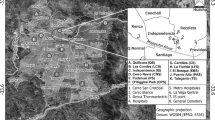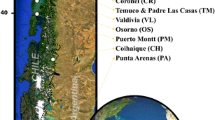Abstract
Intention, Goal, Scope, Background
As the strong negative health effect of exposure to the inhalable particulate matter PM10 in the urban environment has been confirmed, the study of the mass concentrations, physico-chemical characteristics, sources, as well as spatial and temporal variation of atmospheric aerosol particles becomes very important.
Objective
This work is a pilot study to assess the concentration level of ambient suspended particulate matter, with an aerodynamic diameter of less than 10 µm, in the Belgrade central urban area. Average daily concentrations of PM10 and PM2.5 have been measured at three representative points in the city between June 2002 and December 2002. The influence of meteorological parameters on PM10 and PM2.5 concentrations was analyzed, and possible pollution sources were identified.
Methods
Suspended particles were collected on Pure Teflon filters by using a Mini-Vol low-volume air sampler (Airmetrics Co., Inc.; 5 1 min-1 flow rate). Particle mass was determined gravimetrically after 48 h of conditioning in a desiccator, in a Class 100 clean room at the temperature T = 20°C and at about 50% constant relative humidity (RH) .
Results and Discussion
Analysis of the PM10 data indicated a marked difference between season without heating - (summer; mean value 56 ug nr3) and heating season - (winter; mean value 96 µg m3); 62% of samples exceeded the level of 50 µg nr3. The impact of meteorological factors on PM concentrations was not immediately apparent, but there was a significant negative correlation with the wind speed.
Conclusions
The PM10 and PM2.5 mass concentrations in the Belgrade urban area had high average values (77 µg nr3 and 61 µg m3) in comparison with other European cities. The main sources of particulate matter were traffic emission, road dust resuspension, and individual heating emissions. When the air masses are coming from the SW direction, the contribution from the Obrenovac power plants is evident. During days of exceptionally severe pollution, in both summer and winter periods, high production of secondary aerosols occurred, as can be seen from an increase in PM2.5 in respect to PM10 mass concentration.
Recommendation and Outlook
The results obtained gave us the first impression of the concentration level of particulate matter, with an aerodynamic diameter of less than 10 µm, in the Belgrade ambient air. Due to measured high PM mass concentrations, it is obvious that it would be very difficult to meet the EU standards (EEC 1999) by 2010. It is necessary to continue with PM10 and PM2.5 sampling; and after comprehensive analysis which includes the results of chemical and physical characterization of particles, we will be able to recommend effective control measures in order to improve air quality in Belgrade.
Similar content being viewed by others
References
Bogo H, Otero M, Castro P, Ozafran M, Kreiner A, CalvoE, NegriM (2003): Study of atmospheric particulate matter in Buenos Aires city. Atmos Environ 37, 1135–1147 Chaloulakou A, Kassomenos P, Spyrellis N, Demokritou P,
KoutrakisP (2003): Measurements of PM10 and PM2.5 particle concentrations in Athens, Greece. Atmos Environ 37, 649–660
D’Alessandro A, Lucarelli F, Mando P, Marcazzan G, Nava S, PratiP, Valli G, Vecchi R, ZucchiattiA (2003): Hourly elemental composition and sources identification of fine and coarse PM10 particulate matter in four Italian towns. J Aerosol Sci 34, 243–259
Dockery W, PopeA (1994): Acute respiratory effects of particulate air pollution. Annu Rev Public Health 15: 107–132
EEA (2003): Air quality in Europe. State and Trends 1990–1999. Topic Report 4/2002. European Environment Agency, Copenhagen
EEC (1999): European Council Directive 1999/30/EC of 22 April 1999 relating to limit values for sulphur dioxide, nitrogen dioxide and oxides of nitrogen, particulate matter and lead in ambient air. Official Journal; L 163(29/06/1999), 41-60
Gehrig R, BuchmannB (2003): Characterising seasonal variations and spatial distribution of ambient PM10 and PM2.5 concentrations based on long-term Swiss monitoring data. Atmos Environ 37, 2571–2580
Harrison R.M, Deacon A.R, Jones MR, Appleby R.S (1997): Sources and processes affecting concentrations of PM10 and PM2.5 particulate matter in Birmingham (UK). Atmos Environ 37, 649–660
Lazaridis M, Semb A, Larssen S, Hjellbrekke A, Hov O, HanssenJ, Schaug J, TorsethK (2002): Measurements of particulate matter within the framework of the European Monitoring and Evaluation Programme (EMEP). Sci Total Environ 285, 209–235
Lenschow P, Abraham H, Kutzner K, Lutz M, PreubJ, ReichenbacherW (2001): Some ideas about the sources of PM10. Atmos Environ 35, S23-S33
Longley I, Gallagher M, Dorsey J, Flynn M, Allan J, AlfarraM, InglisD (2003): A case study of aerosol (4.6 nm<Dp<10 εm) number and mass size distribution measurements in a busy street canyon in Manchester, UK. Atmos Environ 37, 1563–1571
Lu H, FangG (2002): Estimating the frequency distributions of PM10 and PM2.5 by the statistics of wind speed at Sha-Lu, Taiwan. Sei Total Environ 298, 119–130
Mage D, OttW (1984): An evaluation of the method of fractals, moments and maximum likelihood for estimating parameters when sampling air quality data from a stationary lognormal distribution. Atmos Environ 18, 163–171
Manoli E, Voutsa D, SamaraC (2002): Chemical characterization and source identification/ apportionment of fine and coarse air particles in Thessaloniki, Greece. Atmos Environ 36, 949–961
Marcazzan G, Vaccaro S, Valli G, VecchiR (2001): Characterization of PM10 and PM2.5 particulate matter in the ambient air of Milan (Italy). Atmos Environ 35, 4639–4650
Marcazzan G, Valli G, VecchiR (2002): Factors influencing mass concentration and chemical composition of fine aerosols during a PM high pollution episode. Sci Total Environ 298, 65–79
Qin Y, OduyemiK (2003): Chemical composition of atmospheric aerosol in Dundee, UK. Atmos Environ 37, 93–104
Querol X, Alastuey A, Plana F, Rodriguez S, Plana F, RuizC, Cots N, Massague G, PuigO (2001): PM10 and PM2.5 source apportionment in the Barcelona Metropolitan area, Catalonia, Spain. Atmos Environ 35, 6407–6419
Saitoh K, Sera K, Hirano K, ShiraiT (2002): Chemical characterization of particles in winter-night smog in Tokyo. Atmos Environ 36, 435–440
Samara C, Kouimtzis Th, Tsitouridou R, Kanias G, SimeonovV (2003): Chemical mass balance source apportionment of PM10 in an industrialized urban area of Northern Greece. Atmos Environ 37, 41–54
Schwartz J, Dochery D.W, Neas L.M (1996): Is daily mortality associated specifically with fine particles? J Air Waste Manage Assoc 46, 927–939
Tsitouridou R, Voutsa D, Kouimtzis Th (2003): Ionic composition of PM10 in the area of Thessaloniki, Greece. Chemosphere 52, 883–891
Unkašević M, MališićJ, TošićI (1999): Some aspects of the wind ‘Koshava’ in the lower troposphere over Belgrade. Meteorol Appl 6, 69–80
USEPA (2001). Criteria Document on Particulate Matter, draft report
Vukmirović BZ (1990): Expected levels of air pollution in pseudo/ lognormal distribution. Idojaras 94, 249–258
Author information
Authors and Affiliations
Corresponding author
Rights and permissions
About this article
Cite this article
Rajšić, S.F., Tasić, M.D., Novaković, V.T. et al. First assessment of the PM10 and PM2.5 particulate level in the ambient air of belgrade city. Environ Sci & Pollut Res 11, 158–164 (2004). https://doi.org/10.1007/BF02979670
Received:
Accepted:
Issue Date:
DOI: https://doi.org/10.1007/BF02979670




